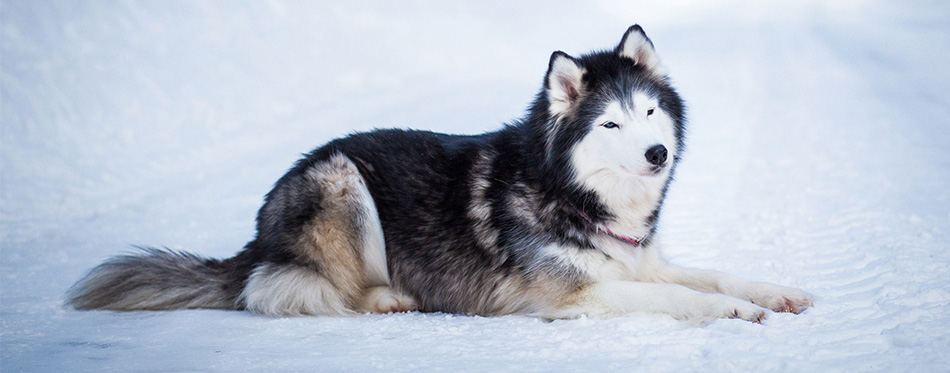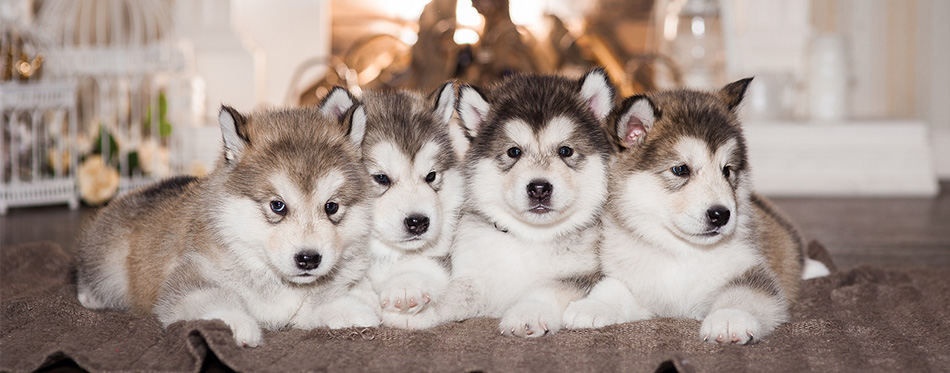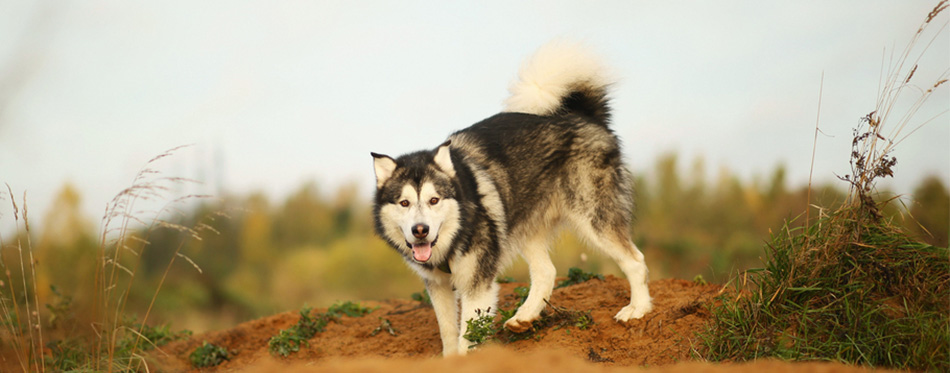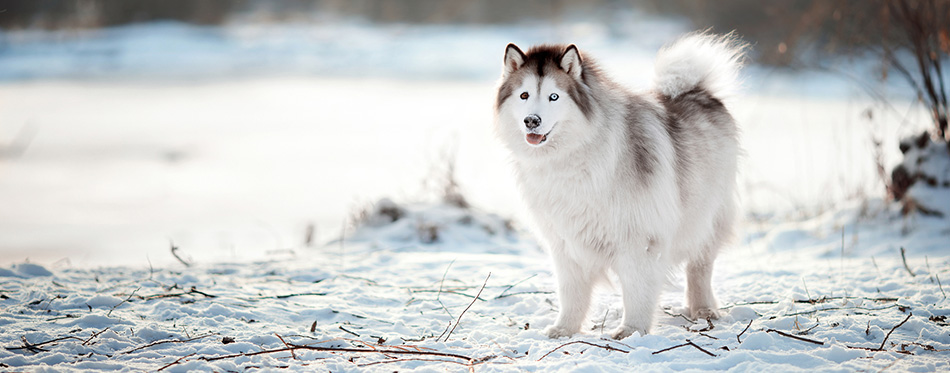Larger and definitely stockier than its Arctic relative, the Siberian Husky, the Alaskan Malamute is one of those beautiful dogs that never fail to elicit admiration from virtually anyone who sees it. Its muscular body, well-defined limbs, a curled tail that touches its back and that signature wolf-like mask all make the Malamute such an amazing dog to have. Fiercely loyal and affectionate to its family and very playful in the company of children, this Nordic giant has been used by the ancient peoples of the north as babysitters. It’s a trait that lives on to this very day. They always have this motherly protective instinct watching over its human master’s children as if they were its own. And if you’re wondering if such a dog will be great to have in your home, then read on.

History of the Alaskan Malamute
We bet you didn’t know that this dog breed has been around for more than two millennia already. The Alaskan Malamute is a dog breed that is closely associated with the Mahlemut people, serving them in many of their pursuits in the harsh environments of Siberia. When these people moved eastwards towards Alaska by way of an ancient land bridge and settled in the northeastern part of Seward Peninsula, they brought with them their dogs that proved highly indispensable for a variety of work.
These dogs were used by the Mahlemut in hunting seals with the dogs alerting them to the presence of blow holes in the ice-covered portions of the sea where seals often pop out to breathe. The Mahlemut dogs were also highly valuable in hunting larger predators in the area including bears. They also pulled heavy sleds filled with food and other supplies for the Eskimos. In return, the Mahlemut people treated their dogs like members of the family, living alongside them, and taking part in their family activities. Because of the freezing conditions in the land, young kids were often nestled in between dogs to keep the babies and young children relatively warm. When food is scarce, some kids are nursed by the dogs themselves together with their puppies.
It is this interdependence that the Mahlemut people and their dogs were able to flourish amidst the largely inhospitable lands just below the Arctic Circle. It is also for this reason that the Mahlemut never wanted their dog to be bred with other dogs, although there are some stories about tribesmen purposely tying their female Malamutes to a tree in the forest in the hope of having it mated by a male wolf. This is in the hope of creating a much larger, stronger breed.
Unlike the Siberian Husky which focuses more on speed and agility, the Alaskan Malamute is all about brute force and strength. Speed is of no importance for the Mahlemut people. What was more important is that they could carry more, heavier, and larger loads with each run.
This trait proved invaluable during the 1896 Klondike Gold Rush. Gold prospectors were in a hurry to get their hands on the strong and muscular Alaskan Malamutes to haul their quarry. Unfortunately, by this time there were only very few true-blue Alaskan Malamutes left because of a massive food shortage that occurred between the 1870s and the 1880s resulting in the demise of many Malamutes.
As such, prospectors crossed the remaining true-breed Malamutes with imported dogs in an effort to improve the breed. Sadly, this resulted in the loss of the many fine qualities of the Alaskan Malamute. Crossbreeding resulted in dogs that ate more and died earlier than original Malamutes. Also, they were sufficiently weaker and slightly smaller in size.
It should be understood that the Mahlemut people closely guarded their dogs and never wanted other tribes to mix their dogs with theirs. This is why the original purebred Malamute was so strong and had a very close relationship with its human family. Sadly, nature drew its course and decimated a great number of this fine breed. Introducing other dogs into the breeding process undermined the high quality of the Alaskan Malamute. As such, if one wanted to have an original purebred Alaskan Malamute, one can only get it from the Mahlemut tribe.
In the early part of the 20th century, Milton and Eva Seeley used the Alaskan Malamutes found in the Norton Sound to create a strain that is later known as Kotzebue. A different Alaskan Malamute strain was also developed by Paul Voelker, Sr. and called this the M’Loot strain. By 1935, the breed officially gained recognition from the AKC with the unrelenting effort of Eva Seeley.
Unfortunately, the Second World War took its toll on the breed that there were only 30 registered Alaskan Malamutes left by 1947. It was through the efforts of Robert J. Zoller that the Alaskan Malamute saw a resurgence. Zoller combined dogs from both the Kotzebue and M’Loot strains as well as Hinman/Irwin dogs to create a new kind of Alaskan Malamute – the Husky-Pak line.
It is sad to think that the original purebred dogs raised and loved by the closely-knit Mahlemut people are long gone. The Alaskan Malamute we see today are no longer the heavyweight yet tender-loving dog that its family loved and cherished. However, it still has many of the characteristics that have endeared this breed to the Mahlemut and to the rest of the world.

Quick Facts
The Alaskan Malamute is not only a handsome dog, but also a venerable working hound. It has proven its mettle time and time again especially in heavy freighting. It’s not bred as a racing sled dog, let’s get that straight. But if you’re hauling your house, this is the breed to do it. Here are other facts that you’d want to know about the Alaskan Malamute.
- Male Malamutes can reach up to 25 inches tall while females will be typically shorter by 2 inches.
- Males can weigh up to 100 pounds, although most will tip the scale at 85 pounds. However, it was once said that the original dogs of the Mahlemut people can reach up to 140 pounds. The female Malamute is typically lighter by 10 to 15 pounds.
- The Alaskan Malamute comes with a double coat that is very dense to help protect it from the harsh Arctic environment. The undercoat is very thick, wooly, and oily.
- This is important to help keep it warm and to repel melting ice. It’s also what keeps the Mahlemut children comfy in bed. The undercoat can be 1 to 2 inches deep.
- The outer coat is usually coarse.
- It is considered in the dog world as the planet’s oldest and largest Arctic sled dog, although we already know for a fact that it’s not a racing sled dog, but a heavyweight freight carrier.
- The Alaskan Malamute best thrives in a large open space as it doesn’t really like being kept within a fence.
- It absolutely adores children, as we have already mentioned about the role it played in the care of Mahlemut kids and babies. Be forewarned though, this is a mammoth fur ball that can easily squish a small child if not supervised.
- Malamutes are a sturdy breed of dog that can live up to 15 years.
Things You Should Know
Revered for its exceptional strength and endurance, the Alaskan Malamute is what you’d call the dog fur factory or the heavyweight freight puller of the canine world. No fence can ever contain this mini behemoth as it generally considers the harsh world its backyard. Despite these, the Malamute remains a joyful, friendly, and exuberant dog that is as fiercely loyal to its family as it is dedicated to its work. And if you’re thinking of bringing one home, read the following first.
Training
In the hands of someone who understands the personality of an Alaskan Malamute, this breed should be relatively easy to train. However, it is crucial that you begin training as early as 8 weeks old. You’ll be amazed at just how much and how fast this breed can assimilate a variety of skills that you’re willing to teach it. Neglect this part of its life and it can literally turn your life into a wilderness. The Alaskan Malamute has a natural curiosity that can only be satisfied by its exploratory behavior. It will dig backyards and rip furniture upholstery just so it learns what is inside these things. With proper training you can somehow temper this innate curiosity in your Malamute.
These dogs may not be as smart as the Border Collie or even the Poodle, but they clearly didn’t survive the harsh Arctic winters by being dumb. They are intelligent and have the same independent-mindedness of their wolf ancestors, especially the Taymyr wolf which they share with their Chukchi-bred cousins, the Siberian Husky.
Feeding
The Alaskan Malamute is the heavyweight worker of the Arctic. The original dogs of the Mahlemut people subsisted mostly on deer, seals, and sometimes bear that families hunted in the wild. It was impossible to plant root crops, vegetables, and fruit-bearing trees as the Arctic environment is simply too harsh for such produce. Yet these dogs were way stronger, larger, and way more enduring than modern-day Alaskan Malamute. What are we saying?
If your Malamute follows the lifestyle of the original Mahlemut dogs, then you should give it raw whole-prey food. It is the closest thing they could ever get to the kind of diet that their Mahlemut dog ancestors subsisted on. If you dislike raw food, then give your dog high-quality animal protein-based dog food that has a protein composition of at least 45% by dry weight basis.
Now, if your Alaskan Malamute has already turned into a couch potato just like the majority of dog owners today, then you should always tone down on its calorie intake as this can definitely lead to obesity and diabetes.
For more guides on choosing the right dog food, you may wish to check out our reviews of the best dry dog food, organic dog food, grain free dog food, high protein dog food and dog food for shedding.

Exercise
Being heavyweight workers of the Arctic, the Malamute requires very vigorous – and we mean very vigorous – exercise. This dog is just like your bodybuilder who is more concerned about lifting more weights than physically possible than it is concerned about speed and grace. It doesn’t care about that. What it cares about is for its muscles to work.
A great exercise to try with Malamutes is programmed weight pulling. They are not racing sled dogs, but they also love pulling things. The heavier the load, the more motivated they can become. They also love very long walks, treks, hikes, skijoring, sledding, and carting. They can run and bounce a lot like Tigger. The point is that they have to get really vigorous exercise if you don’t want their high-energy levels to be translated into canine behavioral problems.
Socialization
To say that Malamutes love kids is obviously an understatement. These Arctic giants look at kids as if they were their own litter. They love to play with their family’s children. Unfortunately, Alaskan Malamutes can grow very fast that a 6-month old puppy can already be a formidable dog for a toddler or a preschooler. That is why these dogs are not best for families with children who are younger than 5 years old.
The Malamute is very friendly to almost anyone, even strangers. So if you’re looking for a watch dog the Malamute clearly isn’t one of your choices. It is a Spitz type of dog, yes, but it is not as vocal as the other Spitzes. You won’t even hear it bark except perhaps for its now famous “woo woo”.
It has a very high prey drive. So if you have small pets in the home such as toy or small breeds of dogs or even cats, there’s a tendency that your Malamute will look at these pets as fair game. The good news is that if you’ve socialized your Malamute growing up with these pets, then it will consider them as its family, too.
Grooming
This breed sheds its fur like a blizzard at least twice a year. And even if it is not snowing with pet hair, you will still find your vacuum cleaner to be fully stretched to its capacity. Daily brushing is advised as this not only prevents mats and tangles, but also promotes the more even distribution of natural oils in the skin. You don’t need to bathe your pet regularly, although if its coat is obviously dirty then a trip to the bathtub is warranted. Generally, you can bathe your Malamute once or twice a year depending on how ‘dirty’ it looks.
Brushing your Malamute’s teeth, clipping its nails, and cleaning its ears should all be done on a regular basis; although a twice-yearly trip to the dog groomer certainly wouldn’t hurt.
You may like some of our dog grooming guides, such as dog toothpaste, dog toothbrush, dog ear cleaner, dog nail clippers, dog nail grinders and dog bathtub.
Health
Original Mahlemut dogs were very sturdy. Sadly, with the introduction of other breeds into the gene pool, today’s Alaskan Malamutes already come with a variety of health problems. This can include cataracts, hip dysplasia, chondrodysplasia, hypothyroidism, Von Willebrand’s disease, and hemeralopia or day blindness.
The Alaskan Malamute is generally recommended for the following folks.
- Loves to exercise or enjoys having outdoor activities
- Can interact with the Malamute for at least 1 hour every day
- Can provide mental challenges to the Malamute
- Knows the principles of advanced dog training and socialization and how to apply them
- Lives in a cold, temperate environment
- Lives in a house with a large backyard or an open space
- Doesn’t mind heavy shedding and digging in the backyard
- Doesn’t mind daily hair-brushing and teeth brushing as well as regular nail-clipping and ear-cleaning
- Has an Alpha personality
This Artic working dog is not suitable to the following individuals.
- Newbie dog owner
- Don’t like dogs that dig in the backyard
- Require a watch dog or a guard dog
- Live in hot and highly humid environments
- A certified couch potato or one who doesn’t exercise or have outdoor activities
- Live in a house with very limited backyard space
- Have allergies, especially pet dander allergies

Temperament
It is very easy to see why the Mahlemut people loved their dogs very much. Its outgoing and playful dispositions plus a caring and comforting attitude towards the human members of their ‘pack’ is clearly something to admire from this dog. Whenever a Malamute meets a person – be it a total stranger or even a first-time guest in the house – you can always expect it to show that warm welcome. They may not be your ideal watch dog, but make no mistake; you can never take away the love of a Malamute for its family especially the children.
Malamutes consider their human family as their pack and as such they expect that they will be included in all family activities. Malamute puppies that have good temperaments are always playful, curious, and friendly. They love nothing more than to be picked up by a ‘new friend’ and be held close to the body. It is intelligent independent, and very resourceful – characteristics that the Malamute obviously gained and developed living in the harshest conditions on the face of the planet.
The dog that the Mahlemut people loved and adored may have long been gone, but many of the dog’s innate traits live on in the modern-day Alaskan Malamute. Forever loyal to its family and greatly motivated to excel in its work, this breed is a wonderful pet to bring to any home that understands its unique needs.
Source:
- Alaskan Malamute – PetMD

